Features
Searching for Cures
and | USF News
In April, Bill Baker traveled to the end of the earth. It wasn’t his first visit to the icy Antarctic; he’s been making the annual trek for 20 years.
Baker is on a mission to bring back specimens — sponges, tunicates, sea anemones, corals and other marine invertebrates — that could hold the keys to treatments for cancer, malaria, Alzheimer’s and other diseases.
The specimens will become part of the natural products library in the chemodiversity laboratory at USF’s Center for Drug Discovery and Innovation (CDDI). There, a team of scientists will screen the samples against known targets for disease.
A reaction could mean the first step in the development of a life-saving drug.
For more than 25 years Baker, a natural products chemist and director of the CDDI, has been studying the chemistry of marine invertebrates, algae and microbiota. His research has taken him from the coastal mangroves of the Florida Keys to the understudied marine environments beneath the Antarctic ice.
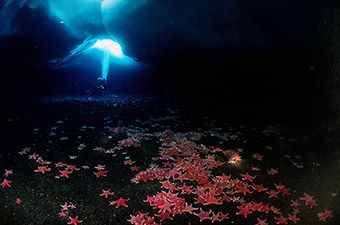
During their long evolution, starfish have developed chemical defenses to survive the harsh Antarctic environment. The very chemical compounds which allow these and other marine organisms to thrive hundreds of feet below the Antarctic ice could be the basis for new drugs to cure cancer and other diseases.
Photo by Norb Wu
Marine organisms, Baker explains, produce a variety of chemical defenses to ward off predators — defenses that have evolved over time. These chemicals interact with a predator’s biological receptors much in the same way drug molecules interact in humans.
“Drugs interact with a person’s biological receptors. So receptors in these defensive situations aren’t that different than receptors in disease states,” Baker says. “So the fact that a chemical defense for a sponge has activity against cancer is not all that surprising.”
Finding the compounds that can alter the function of targeted cells can take thousands of samples and hundreds of tests. It can take millions of dollars and dozens of years.
It’s like looking for a needle in a haystack.
At the CDDI, a Florida Center of Excellence, scientists like Baker are involved in the earliest stages of drug discovery — identifying disease markers and molecular targets; isolating compounds from source organisms; screening natural and synthetic compounds against selected targets; and testing and optimizing potential new drugs for activity, selectivity, pharmacokinetic properties, reliability and cost.
It’s basic research; research that used to be the exclusive domain of pharmaceutical companies but in recent years has seen a shift to academia.
USF’s collaborative, interdisciplinary center brings together highly specialized equipment, an extensive natural products library, advanced analytic capabilities and the expertise of chemists, biologists, pharmacologists and other researchers to overcome some of the critical bottlenecks in the drug discovery pipeline.
“CDDI recognizes the expertise that we have across campus — the College of Medicine, the College of Public Health, the College of Engineering, the College of Marine Science, the College of Arts and Sciences. Drug discovery is going on all over campus; it’s amazing how common it is.”
“The research is biological at times, it’s pharmacological at times, and it’s chemical at times,” Baker says. “What CDDI strives to do is bring together those disparate groups to make projects.”
Like finding a cure for malaria.
USF researchers played a key role in the discovery of a promising new drug with the potential to cure malaria and block its transmission (see story pg. 26). The USF researchers, led by Roman Manetsch, associate professor of chemistry, and Dennis Kyle, professor of global health in the College of Public Health, were part of an international, multidisciplinary research team.
Using advanced technology, the researchers identified a potential new drug derived from an old class of antimalarial compounds. The candidate drug is now moving toward clinical testing, the ultimate goal for early-phase drug discovery.
Jim Leahy, a medicinal organic chemist and professor in the CDDI, calls the malaria project a perfect example of the process of taking a drug from the initial synthesis of molecules to the clinical trial phase — a process he says has taken about three years, not including the time spent looking for the target and searching for the right compound to make.
Given that the drug has not yet entered human trials, it seems likely that it is still at least seven years away from becoming an approved drug.
Identifying a target — a biomarker for disease, such as cancer, Parkinson’s, Alzheimer’s or malaria — is the first step in drug discovery. Once validated, researchers develop an assay, or test, to screen the target against thousands of compounds. At the CDDI, those compounds typically come from Baker’s collection — one of the nation’s largest and most unique collections of natural product samples. The researchers look for a “hit,” or reaction, that could turn into a lead for a new drug.
But getting a hit is just the beginning.
Next, scientists must optimize the drug for activity and pharmacokinetic properties, such as solubility, absorption, metabolism and potency. They must ensure the drug does more than reach its target; it has to stick around long enough to do the job, but not too long. It has to be selective; it has to be safe and reliable; and it has to be affordable.
“It’s definitely a balancing act; we optimize for everything,” says Leahy. “A lot of times hard decisions come up because you may have a compound that isn’t as active, but you can make more metabollically stable or synthesize it for 1/100th of the cost. So you have to compromise in some ways to find the compound that is the most ideal version in all of these categories that can become a reasonable drug.”
Optimizing potential new drugs means changing the structure of compounds to make them safer and more effective; for example, altering the design of a drug molecule to enable it to more powerfully bind to the parts of the target where it can have the greatest impact.
It’s a process made possible with advanced chemistry techniques and faster technologies such as nuclear magnetic resonance, crystallography, computer modeling and mass spectrometry. The highly specialized technologies are available to researchers in the CDDI’s laboratories and core facilities, including a chemodiversity laboratory, a proteomics facility, a protein production and cell biology laboratory, and a high field nuclear magnetic resonance facility.
Lindsey “Les” Shaw, a microbiologist and associate professor in USF’s Department of Cell Biology, Microbiology and Molecular Biology, calls CDDI “an umbrella organization that brings the right people together.”
“It can connect people like Bill Baker, Jim Leahy, Dennis Kyle, Roman Manetsch and me,” he says. “We all have this collective experience of drug discovery and delivery.”
Shaw is working with researchers at the CDDI to identify new antibiotics that could prove effective against the top six hospital-acquired bacterial infections in the United States today.
The bugs, or so-called ESKAPE pathogens (with each letter representing one of the different bacteria), are responsible for the majority of the 100,000 deaths from hospital-acquired infections seen in the U.S. each year.
“We’ll take compounds from anyone to identify hits that we can turn into leads,” Shaw says.
Right now he’s focused on the CDDI’s natural products library, which in addition to marine specimens from the Antarctic, includes understudied fungi from the Florida Everglades and Florida Keys.
In the wild, fungi coexist with bacteria in the soil. Perhaps some manipulation of the chemical defenses developed by fungi to ward off infection could be effective for humans.
“But it’s not just about taking Everglades fungi and looking for something new; we have this cool epigenetic modification where we manipulate the fungi chemically and spook them into making new things,” Shaw says. “The fungus makes compounds we then use to try to kill the bacteria.” Shaw’s research, like much of the work under way at the CDDI, is being funded by a federal grant.
“The beauty of what we do is one compound goes six ways because I have six different types of bacteria so I get six times the data,” he says. “We used to just work on MRSA (Methicillin-resistant Staphylococcus aureus) and then we decided to expand because there were so many hits that we were missing.”
Finding hits and developing leads is a highly collaborative, interdisciplinary effort.
“It’s a full university endeavor,” Baker says, “with contributors from all over.”
-
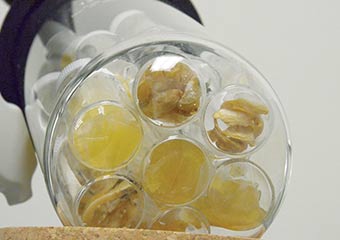
Collecting Samples
Extracts of natural compounds are dried and curated in the chemodiversity lab at CDDI.
Photo by Katy Hennig | USF News
-

Collecting Samples
CDDI Director Bill Baker collects and explores compounds from around the world to catalog and screen against potential drug targets.
Photo by Katy Hennig | USF News
-

Collecting Samples
Baker and his team dive below the ice in the Antarctic Sea to gather sponges, tunicates and corals. They’ve recently returned from a trip during which they gathered samples using a trolling technique.
Photo by Chuck Amsler
-
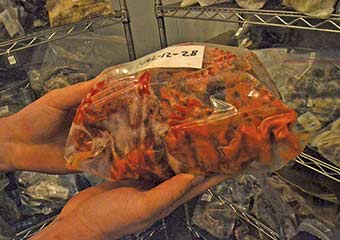
Collecting Samples
The samples are frozen and shipped to the chemodiversity lab where they are stored in the natural products library in a sub-zero freezer at minus 20 degrees Celcius.
Photo by Katy Hennig | USF News
-
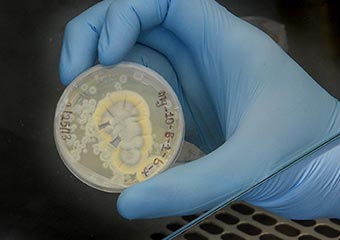
Seeking a Hit
A culture from a fungus sample grows in the chemodiversity lab at CDDI.
Photo by Katy Hennig | USF News
-
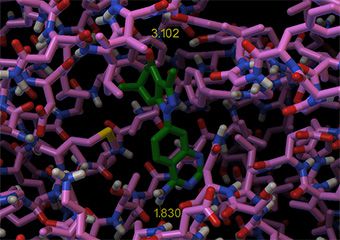
Seeking a Hit
A crystal structure view of the protein shows a small molecule (green) binding inside a pocket in the active site of the protein. The molecule can be optimized to interact and control activity in the cell.
Photo courtesy of Jim Leahy
-
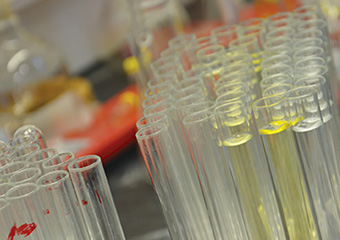
Seeking a Hit
The molecules go through a filtration and purification process based on their polarity.
Photo by Katy Hennig | USF News
-
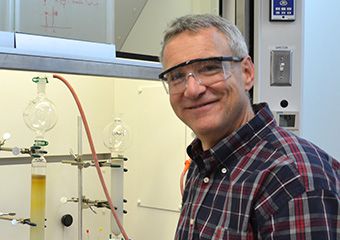
Seeking a Hit
Medicinal chemist Jim Leahy works to optimize the activity, pharmacokinetic properties, reliability and cost of developing small molecules.
Photo by Katy Hennig | USF News
-

Seeking a Hit
Microscopic image of immunofluorescence of a cell.
Photo courtesy of Jim Leahy
-

Researchers extract endophytes from the fungi in mangrove tissues. The endophytes have diverse characteristics, based on the harsh environments in which they grow.
Photo by Katy Hennig | USF News